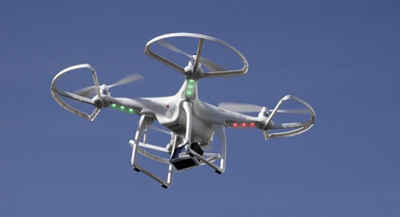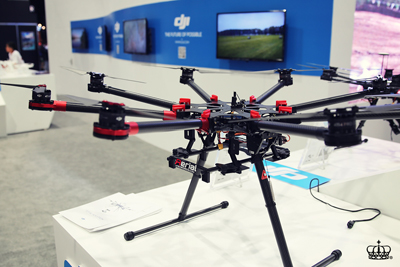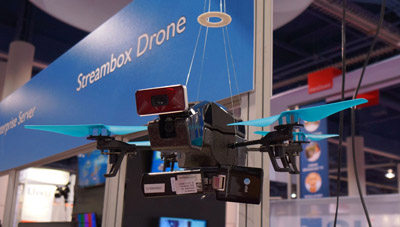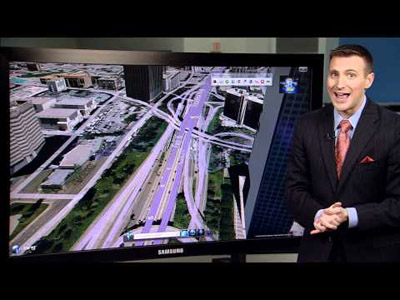Drones Over NAB
LAS VEGAS—Every year at the annual gathering, one or more technologies create a significant buzz among attendees. This year that buzz could be heard loud and clear--coming from four (or more) propeller blades attached to a flying drone, or Unmanned Aerial Vehicle, or UAVs, as they are known in the industry, with miniature HD cameras on board.
Billed alternately as an ideal way to gain unique perspectives for movies and video projects, as well as the new tool for TV news stations to put a journalist's eye in the sky, the catalysts for this rather simple: They are a lot less expensive than a helicopter and, because they are not regulated by the FAA at this point, can go virtually anywhere in the hands of a skilled remote control operator. There is even a Professional Society of Drone Journalists (PSDJ), representing users of the technology, so widespread use of UAVs in newsgathering will come sooner or later.

The FAA has yet to figure out how best to regulate the use UAVs for newsgathering. The FAA is in charge of regulating UAVs, but they have yet to provide any guidelines and the agency has stated it won't meet a 2015 deadline for doing so. In the meantime, it's technically illegal to operate a UAV for commercial use, and can result in a $10,000 fine.
Drones used in the military often have a negative connotation, but video industry users of these drones have the feel of a model airplane hobbyist. Yet, the industry, and indeed the general public, have become increasingly concerned for the safety of those below. And local and national government has yet to figure out what to do with this emerging ENG tool.
In February, Pedro Rivera, a freelance news photographer for WFSB-TV in Hartford, Conn., shot an accident from above on his day off and was suspended for a few days by his station management. Rivera, in turn, has sued the Hartford Police Department in U.S. District Court, claiming a police officer demanded his employer discipline him after he flew the drone over the accident scene. Hartford police told news agencies that they were concerned about the drone intruding on the accident victim's privacy.
In an email to the PSDJ, Rivera wrote that journalists on the ground obtained more intrusive images than his drone was capable of taking.
"If privacy is a concern, it was not with me," Rivera wrote. He used a DJI Phantom 2 Vision drone, flying about 150 feet above the ground when it took the photo, and was not equipped with any kind of magnifying lens. Rivera's drone is GPS-enabled, which is often used for stability, but can also be used to record where the drone was when it took photos. PSDJ said that, according to the EXIF data stamped on Rivera's image, the drone was approximately 150 feet from the accident site when it took the photo.

Pedro Rivera, a freelance news photographer for WFSB-TV in Hartford, Conn., used a DJI drone on his free time and was suspended by the station after local police intervened. "It was with all the local news stations that were on the sidewalks with 'long lenses' and had shots so tight, that you could see inside the crash vehicle," he told the PSDJ website.
Controversy aside, several major media companies, such as Facebook and Google, have purchased companies that make drones in an effort to leverage the technology for wide range of applications: from package delivery to enhancing wireless Internet coverage, with both of these entities using solar-powered vehicles. Both Facebook and Google have launched projects that aim to get everyone on the planet online. (In addition to drones, Google's "Project Loon" plans to send giant balloons bearing Internet-beaming antennas into the stratosphere.)
These flying contraptions with GoPro and other miniaturized HD cameras are even being tested by networks like ABC. Vince Roberts, Chief Technology Officer at the Walt Disney Company, has said ABC will use UAVs among its news crews, when the time is right.
"I believe this could be a bullion dollar business in the U.S., " he said. "We see UAVs as a good alternative for newsgathering, but they have to be much more robust and provide longer flight times. Once the FAA clears the deck, we have newsgathering, we have production and all kinds of application where these vehicles could really be valuable to a news station."
At the NAB Show, battery-operated and solar-powered UAVs were clearly in evidence in the Central Hall of the Las Vegas Convention Center. There were demonstrations from such companies as DJI (Hong Kong, with its "Phantom 2"), Zero UAV (Beijing, with its "E1100-V2" series) Intelligence Technology Co., Ltd; and YUNEEC Technology (China, with its "Flying Eyes UAV"), to name a few.
A company in the U.S. called Streambox showed its Streambox Drone, a miniature video device for security and streaming, weighing 3 ounces, with an integrated HD/SD video camera mounted on a UAV drone. The Streambox Drone includes an on0-board mobile video encoding device that streams live videos over bonded 3G, 4G, LTE and Wi-Fi networks to the cloud-based Streambox Live Service; where the video is transcoded in real-time and streamed to the web and mobile devices.

The Streambox Drone's ACT-L3 video compression and LDMP networking technology have been adopted by broadcasters around the world for newsgathering. The miniature Streambox Drone video device is a unique solution for surveillance and security, or streaming from the air or from the ground, with video streaming capabilities over multiple 3G/4G cellular and Wi-Fi networks all at the same time and is integrated with the latest mobile hardware.
The Streambox Drone's ACT-L3 video compression and LDMP networking technology have been adopted by broadcasters, government, military and enterprise organizations around the world for newsgathering, video transport, video asset acquisitions, and streaming. This same video technology and solution was used by Solar Impulse to stream video from the air on its Across the America Flight in 2013.
For security and surveillance organizations, many Streambox Drones could be placed on UAV/Drones, mounted in vehicles, be worn by officers, or placed in areas to acquire high volumes of live videos to be streamed to command and control centers where the video can be managed, streamed and played out. At the control centers, the Streambox Enterprise server can be deployed to receive hundreds of live videos with automated metadata-based routing. The video can be sent to media players in media walls across a given network for video playout and/or be streamed to officers' mobile devices, desktops, and laptops at the same time. Streambox offers the same capabilities as the Enterprise Server in its cloud-based Streambox Live Service, for those organizations wanting to use the "Cloud" for back-end operations.
Also at the NAB Show, AccuWeather announced that it has developed an application to allow live videos shot with drones to be integrated live with its StoryTeller interactive presentations into local newscasts. The company said downloading and using StoryTeller applications and features that allow the integration of this remote video is now as fast and easy as adding an app to a smartphone.

AccuWeather's StoryTeller Interactive Touchscreen News Solution integrates Drone HD video into an interactive touchscreen solution, putting a station's drone right into the action of any news story. "As stations find new ways to cover breaking news stories, StoryTeller is there to support and enhance their efforts," said Ryan Ayres, Vice President of Display Systems and Services for AccuWeather, Inc. "Integrating Drone technology is one more way that StoryTeller continues to stay on the cutting edge of technology to attract more viewers to local newscasts."
StoryTeller Interactive Touchscreen News Solution integrates Drone HD video into an interactive touchscreen solution, putting a station's drone right into the action of any news story using any StoryTeller app with video capability.
What's clear is that drone performance will get better (more run time and improved stability) and their flight capabilities more reliable with time. Every news station wants to get closer to the action, whether that be with an IP video transmitter mounted on a camera, in a backpack or on a drone. The goal is to give viewers a unique perspective that can't on competing stations. The industry (both manufacturers and broadcasters) appears ready to use the technology, now it's up to the FAA to figure out the logistics.
Get the TV Tech Newsletter
The professional video industry's #1 source for news, trends and product and tech information. Sign up below.
